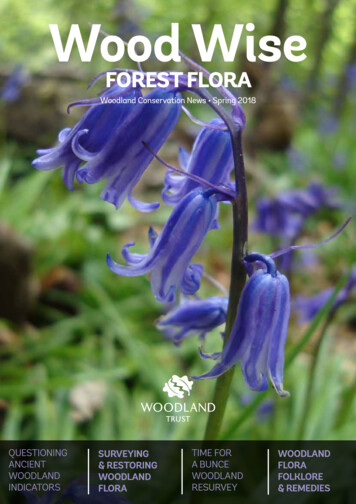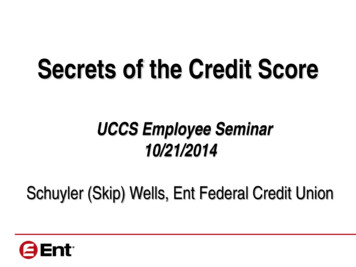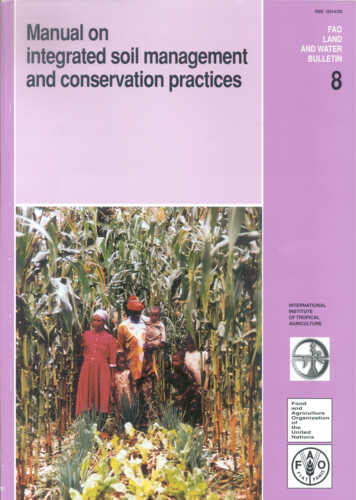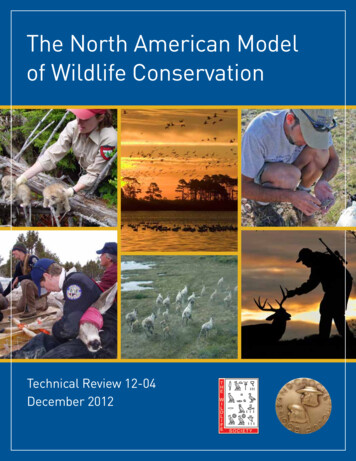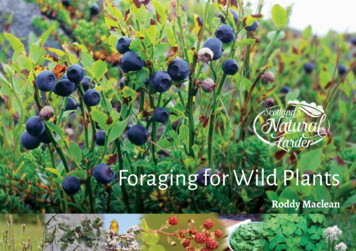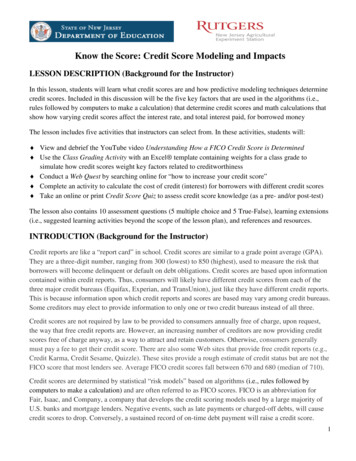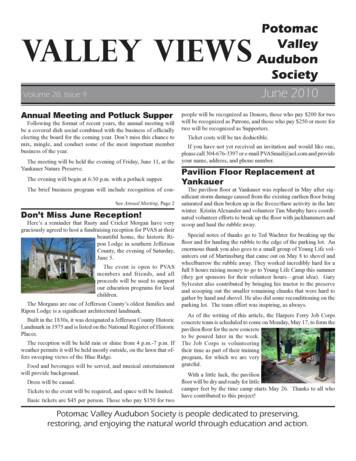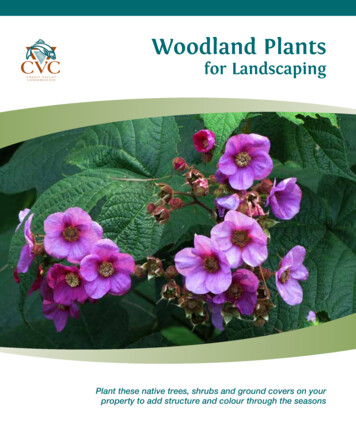
Transcription
Woodland Plantsfor LandscapingPlant these native trees, shrubs and ground covers on yourproperty to add structure and colour through the seasons
Woodland Plants for LandscapingMost woodland plants thrive in the shade or partly shaded areas. Shade from existing treesor nearby structures such as buildings or fences can create ideal conditions for woodlandplantings. You can grow woodland edge species that prefer part sun in areas of your propertythat get four to six hours of sun each day. For easy care, choose plants suited to the conditionsin your landscape.Sun ExposureFull sun: Six or more hours of direct sunlight.Part shade/Part sun: Four to six hours ofdirect sunlight.Full shade: Zero to four hours of directsunlight.Soil TypeUse a shovel to dig down 15 cm (6 inches)and grab a handful of soil. If it is very dryadd a small amount of water to moisten it.Sand: Feels very gritty. Moistened soil doesn’thold together when squeezed.Loam: Feels fairly soft and smooth withsome grit and nearly equal parts of sand, siltand clay.Some loams will feel slightly more on thesmooth side (Clayey-Loam or CL), or slightlymore on the gritty side (Sandy-Loam or SL).Clay: Moistened soil feels smooth and stickyand forms a ball easily when squeezed. Drysoil is hard.Rub the soil between your thumb and fingers.Soils may have other properties such asHow does it feel? Squeeze it together. Does itthe addition of gravel or heavy clay soils,hold together or form a ball?sometimes found in new developments.Choose compaction tolerant species tosurvive in these soils.Match plants from this list to your specific site conditions. Consider sun, soil, moisture and more.Do you have soil that never dries? Try our moist-wet list starting on page 30.Do you have dry soil that you don’t want to water? Select plants from our dry-moist list starting onpage 6.2Cover Photo: Purple Flowering Raspberry Credit: Not On Your Nelly
MoistureSpreadSandy soil holds very little water, while clayAs plants grow they need space to spreadsoil can hold much more. Examine yourout. Give your plants space by consideringproperty throughout the year and note wherehow far each one will spread and leavewater accumulates or drains rapidly.enough space around them for other plants,Dry-moist: Soil is cool and damp afterbuildings or structures.rain but water drains quickly. Soil feels drybetween rains and water doesn’t puddle.Ground may be slightly elevated.Moist-wet: Soil feels damp most of the yearand drains slowly. Water puddles easily. Thisis common in low-lying sites.HeightIn natural woodlands you will notice differentheights or layers of plants. When choosingplants for your property, consider how tallthey will grow rather than how tall they areright now. The plants on this list have beendivided by height to make selecting the right medium to tall trees (greater than 15 m) large shrubs and small trees (4 to 15 m) small to medium shrubs (less than 4 m) ground layer (includes wildflowers, grassessedges and ferns)Canada Wild GingerPhoto: Fritz Flohr Reynoldsplants easier: vinesSelect plants from two or more layers to makeyour planting look lush, healthy and attractive.3
Why Native PlantsNative plants have evolved for hundreds, sometimes thousands, of years in our area, becomingaccustomed to our climate, soils and other conditions. These plants evolved with local wildlife,such as birds and pollinators who use them for food, shelter and other basic needs – needsthat non-native plants often cannot meet.Many native plants still grow in natural areas within the Credit River watershed. The plantsincluded in this list are all native to southern Ontario and most are native to the watershed.These plants make excellent garden and landscaping plants when planted in the right soil, lightand moisture conditions, as described for each plant.Credit Valley Conservation (CVC) recommends using native plants commonly found in the watershed.Native plants that are rare within the watershed have been identified with an asterisk(*).These can be added to gardens and landscaping, but are not appropriate for restorationWhite Trillium4Photo: Aaron Carlsonprojects or projects that require a CVC permit.
Photo: Jon ClaytonWhite Admiral on White CedarRestoration Projects and Planting in Regulated AreasRestoration projects and those requiring a CVC permit must use common species native to theCredit River watershed. Common native plants on this list are those without an asterisk. For acomplete list of approved plants for CVC planning applications and restoration projects refer to:www.creditvalleyca.ca/plantselectionguide.5
Common NameScientific NameSunSoilSpread(m)Dry - Slightly MoistAnemone, WoodAnemone quinquefoliaSLCN/AAster, Heart-leavedSymphyotrichum cordifoliumSLCN/AAster, Large-leavedFormer scientific name:Aster macrophyllaSLCN/ABaneberry, RedActaea rubraSLCN/ABaneberry, WhiteActaea pachypodaSLCN/ABellwort, Large-floweredUvularia grandifloraLN/ABloodrootSanguinaria canadensisSLCN/ABunchberry*Cornus canadensisLN/AWood AnemoneFull sun: 6 or more hours of sunlight;Heart-leaved AsterLarge-leaved AsterPart shade: 4-6 hours of sunlight;Soil: S Sand; L Loam; C Clay6Photo: rockerBOOPhoto: Tom PotterfieldWildflowersEurybia macrophylla* Not for restoration or projects requiring a CVC permit, see p. 5.Shade: 4 or less hours of sunlightRed Baneberry
DrCpStFall ColourFlower Colourby MonthTolerancesJuAMJJASONotesNLarge flower on long stalk; Attractive whorls ofleaves; Spring ephemeralAttractive clusters of small flowers; Heart-shapedlower leavesAttractive clusters of small flowers; Very large, heartshaped lower leaves; Stems often purplishClusters of feathery flowers; Bright red berries insummer; Attractive leavesClusters of feathery flowers; White berry with blackdot resembles dolls’ eyes; Attractive leavesUnique bell-like flowers with drooping leaves;Clump-formingLarge flowers; When emerging the leaves wraparound the flower stalk; Effective ground coverClusters of small red berries in summer; EffectivePhoto: Iahvakground cover; Prefers acidic soilWhite Baneberryred,orange,yellow,Large-flowered Bellwortgreen,pale lver,white,evergreenTolerances: Cp Compaction; Dr Drought; St Salt; Ju Juglones (substance produced by walnut trees)Plants noted as “vigorous” are not recommended for small yards7
Common NameScientific NameSunSoilSpread(m)WildflowersDry - Slightly MoistCohosh, Blue*Caulophyllum thalictroidesSLCN/AColumbine, WildAquilegia canadensisSLCN/ADutchman’s Breeches*Dicentra cucullariaSLCN/AFalse Solomon’s-sealMaianthemum racemosumLN/AMaianthemum stellatumLN/ATiarella cordifoliaSLCN/AGeranium maculatumSLCN/ASolidago caesiaSLCN/AFalse Solomon’s-seal,Star-floweredFoamflower, Heart-leavedGeranium, WildOther name: Spotted GeraniumPhoto: Nature ServeGoldenrod, Blue-stemmedBlue CohoshFull sun: 6 or more hours of sunlight;Wild ColumbinePart shade: 4-6 hours of sunlight;Soil: S Sand; L Loam; C Clay8Dutchman’s Breeches* Not for restoration or projects requiring a CVC permit, see p. 5.False Solomon’s-sealShade: 4 or less hours of sunlight
DrCpStFall ColourFlower Colourby MonthTolerancesJuAMJJASONotesNWhen emerging, leaves are blue-purple; Clusters ofbright blue berries in summerAttractive dangling flowers add colour in earlyspring; Effective ground coverFlowers resemble pairs of pants hung out to dry;Attractive fern-like leaves; Spring ephemeralGraceful arching stems; Cluster of flowers at stem’stip; Pink-red berries in fallGraceful arching stems; Cluster of star-shapedflowers at stem’s tip; Dark blue berries in fallFeathery flowers look like foam;Effective ground coverAttractive deeply-cut leaves; Unique seed capsules;Effective ground coverClusters of flowers along the blue-green stem;Star-flowered FalseSolomon’s-sealred,orange,yellow,Photo: IahvakPhoto: Tab TanneryClump-formingHeart-leaved Foamflowergreen,pale green,blue,Wild ver,white,evergreenTolerances: Cp Compaction; Dr Drought; St Salt; Ju Juglones (substance produced by walnut trees)Plants noted as “vigorous” are not recommended for small yards9
Common NameScientific NameSunSoilSpread(m)WildflowersDry - Slightly MoistGoldenrod, EarlySolidago junceaSLCN/AGoldenrod, ZigzagSolidago flexicaulisSLCN/ALeek, WildAllium tricoccum var. tricoccumLN/ALily, Wood*Lilium philadelphicumSLCN/AMay-applePodophyllum peltatumSLCN/AMaianthemum canadenseSLCN/AMayflower, CanadaOther name: Wild Lily-of-the-valleyAgeratina altissimaSLCN/AHairy Solomon’s SealPolygonatum pubescensSLCN/AEarly GoldenrodFull sun: 6 or more hours of sunlight;Photo: Dan MullenZigzag GoldenrodPart shade: 4-6 hours of sunlight;Soil: S Sand; L Loam; C Clay10Photo: Tom PotterfieldFormer scientific name:Eupatorium rugosumPhoto: Dan MullenSnakeroot, White* Not for restoration or projects requiring a CVC permit, see p. 5.Wild LeekShade: 4 or less hours of sunlightWood Lily
DrCpStFall ColourFlower Colourby MonthTolerancesJuAMJJASONotesNElongated clusters of flowers at the end ofupright stems; One of the earliest goldenrods tobloom; VigorousStems are zig-zagged near the tip; VigorousTwo long, oval leaves with mild, oniony scent appearearly spring; Round cluster of flowers at stem’s tip;cluster of black seeds in fall; Spring ephemeralAttractive large, upward-facing flowersFlower hides below large umbrella-like leaves;Dangling, lemon-shaped fruit in summer;Effective ground coverClusters of tiny star-like flowers; Pale redberries in fallFlat-topped clusters of tiny flowers; Upright,dense branchesFlowers dangle from gracefully arching stem; BluePhoto: Kerry WoodsPhoto: Tom Potterfieldberries in summerMay-applered,orange,Canada Mayfloweryellow,green,pale green,blue,White Snakerootpurple,pink,brown,Hairy Solomon’s Sealsilver,white,evergreenTolerances: Cp Compaction; Dr Drought; St Salt; Ju Juglones (substance produced by walnut trees)Plants noted as “vigorous” are not recommended for small yards11
Common NameScientific NameSunSoilSpread(m)Strawberry Bush, Running*Euonymus obovatusSLCN/ASunflower, WoodlandHelianthus divaricatusSLCN/ATrillium, WhiteTrillium grandiflorumSLCN/ATrout-lily, YellowErythronium americanum ssp. americanumSLCN/AViola sororiaSLCN/AViolet, Common BlueOther name: Woolly Blue VioletViolet, YellowViola pubescensSLN/AViolet, Round-leaved Yellow*Viola rotundifoliaSLN/AViolet, Sweet WhiteViola blandaSLN/APhoto: Jon ClaytonWildflowersDry - Slightly MoistRunning Strawberry BushWoodland SunflowerFull sun: 6 or more hours of sunlight;Part shade: 4-6 hours of sunlight;Soil: S Sand; L Loam; C Clay12* Not for restoration or projects requiring a CVC permit, see p. 5.White TrilliumShade: 4 or less hours of sunlightYellow Trout-lily
DrCpStFall ColourFlower Colourby MonthTolerancesJuAMJJASONotesNUnique pink and orange seed capsules in summer;Effective ground coverMultiple large flowers on each stem;Taller than 1m; VigorousRed berries in summer; Requires rich soilSpeckled leaves similar to spots on trout fish;Emerge before spring leaf-out; Spring ephemeralFuzzy heart-shaped leaves; Effective groundcover; VigorousFlower has purple streaks; Fuzzy leavesFlower has purple streaks; Round basal leavesFragrant flowers on reddish stems; Heart-shapedPhoto: Peter Gormanbasal leaves; Effective ground coverCommon Blue Violetred,orange,yellow,Yellow Violetgreen,pale green,Round-leavedYellow Violetblue,purple,pink,brown,Sweet White Violetsilver,white,evergreenTolerances: Cp Compaction; Dr Drought; St Salt; Ju Juglones (substance produced by walnut trees)Plants noted as “vigorous” are not recommended for small yards13
Common NameScientific NameSunSoilSpread(m)SLCN/AGaultheria procumbensSLN/ABracken FernPteridium aquilinumSLN/AChristmas FernPolystichum acrostichoidesSLN/AMarginal Wood FernDryopteris marginalisLN/ABottlebrush GrassElymus hystrixLN/AEbony Sedge*Carex eburneaSN/APennsylvania SedgeCarex pensylvanicaSLCN/AWild-ginger, CanadaWintergreenOther name: Eastern TeaberryAsarum canadenseCanada Wild-gingerFull sun: 6 or more hours of sunlight;Photo: Jason SPhoto: Tom PotterfieldGrasses & SedgesFernsWildflowersDry - Slightly MoistWintergreenPart shade: 4-6 hours of sunlight;Soil: S Sand; L Loam; C Clay14* Not for restoration or projects requiring a CVC permit, see p. 5.Bracken FernShade: 4 or less hours of sunlightChristmas Fern
DrCpStFall ColourFlower Colourby MonthTolerancesJuAMJJASONotesNRoot smells like ginger; Large, heart-shaped leaves;Effective ground coverLeaves and fruit smell like wintergreen; Evergreenleaves, bright red berries provide winter interest;Prefers acidic soil; Effective ground coverHairy, silvery fiddleheads emerge in early spring;Fronds tilt to almost horizontal; VigorousSilvery fiddleheads emerge in early spring;Evergreen, provides winter interest; Clump-formingHairy golden-brown fiddleheads emerge in earlyspring; Evergreen, provides winter interestSeed heads look like a bottlebrush; Persist into fall;Emerges early spring; Clump-formingNarrow leaves; Tiny black seeds in fall; Emergesearly spring; Clump-formingBright green, arching, narrow leaves; Emerges earlyMarginal Wood Fernred,orange,yellow,Bottlebrush Grassgreen,pale green,blue,Ebony Sedgepurple,pink,brown,Photo: imagefreedotorgPhoto: Tom PotterfieldPhoto: proteinbiochemistspring; Clump-formingPennsylvania Sedgesilver,white,evergreenTolerances: Cp Compaction; Dr Drought; St Salt; Ju Juglones (substance produced by walnut trees)Plants noted as “vigorous” are not recommended for small yards15
Common NameScientific NameSunSoilSpread(m)SN/ASLCN/AStellate SedgeCarex radiataBittersweet, AmericanCelastrus scandensDewberry, Northern*Rubus flagellarisSLN/APartridge-berry*Mitchella repensSLCN/AGrape, RiverbankVitis ripariaSLCN/AParthenocissus insertaSLCN/ACreeper, Virginia*Parthenocissus quinquefoliaSLCN/AArrowwood, Downy*Viburnum rafinesquianumSL1-2Thicket CreeperPhoto: Per VerdonkPhoto: dogtooth77ShrubsOther name: Virginia CreeperStellate SedgeAmerican BittersweetFull sun: 6 or more hours of sunlight;Northern DewberryPart shade: 4-6 hours of sunlight;Soil: S Sand; L Loam; C Clay16Photo: Kara JonesVinesSedgesDry - Slightly Moist* Not for restoration or projects requiring a CVC permit, see p. 5.Shade: 4 or less hours of sunlightPartridge-berry
DrCpStFall ColourFlower Colourby MonthTolerancesJuAMJJASONotesNClusters of star-like seeds; Emerges early spring;Clump-formingWoody climbing vine; Attractive clusters of orangeand red seed capsules persist through winter; Donot confuse with Asiatic Bittersweet (Celastrusorbiculatus) which is non-native and invasiveThorny, trailing vine; Purple berries in summerWoody stems; Red berries in summer; Small round,evergreen leaves provide winter interestReddish-brown peeling bark;Dark blue grapes in summerDark blue berries in summer; Not a selfclinging climber (clings by twining); Looks likeParthenocissus quinquefolia; VigorousDark blue berries in summer; Clinging climber(adhesive disks cling to surfaces); Looks likeParthenocissus inserta; VigorousBluish-black berries in late summer; Dense,Riverbank Grapered,orange,yellow,Thicket Creepergreen,pale green,blue,Photo: Suzanne CadwellPhoto: Melanie KramerPhoto: Dawn PerryPhoto: Carolannie eyewitnessfine-textured branchingVirginia Creeperpurple,pink,brown,Downy Arrowwoodsilver,white,evergreenTolerances: Cp Compaction; Dr Drought; St Salt; Ju Juglones (substance produced by walnut trees)Plants noted as “vigorous” are not recommended for small yards17
Common NameScientific NameSunSoilSpread(m)SLC1-1.5Dry - Slightly MoistBush-honeysuckle, NorthernDiervilla loniceraFormer scientific name:Potentilla fruticosaSLC1-1.5Dogwood, GrayCornus racemosaSLC3-4Dogwood, RoundleavedCornus rugosaSL2-3SLC2-3SLC2-3SL2-3SLC1-2Elderberry, CanadaOther name: Common ElderberrySambucus canadensisFormer scientific name:Sambucus pubensHazelnut, BeakedCorylus cornutaHoneysuckle, Canada FlyLonicera canadensisNorthernBush-honeysuckleFull sun: 6 or more hours of sunlight;Photo: brewbooksShrubby CinquefoilPart shade: 4-6 hours of sunlight;Soil: S Sand; L Loam; C Clay18* Not for restoration or projects requiring a CVC permit, see p. 5.Gray DogwoodPhoto: Kerry WoodsElderberry, RedPhoto: Arthur ChapmanSambucus racemosaPhoto: Superior National ForestSmall - Medium Shrubs ( 3m)Dasiphora fruticosaCinquefoil, Shrubby*Roundleaved DogwoodShade: 4 or less hours of sunlight
DrCpStFall ColourFlower Colourby MonthTolerancesJuAMJJASONotesNAttractive peeling bark reveals orange inner bark;Clusters of tubular flowers; Sends out suckers: clipor use in hedgerowAttractive peeling bark reveals orange inner bark;Dense, fine-textured branching; Attractive greyishgreen leavesCone-shaped cluster of flowers; White berries onred stems in summer; Stems provide winter interest;Sends out suckers: clip or use in hedgerowFlat-topped clusters of flowers; Light-blue berries onred stems in summerVery large, flat-topped, fragrant clusters of flowers;Clusters of purple-black fruit late summer to fall;Suitable for hedgerowsCone-shaped cluster of flowers; Clusters of red fruitin summerCatkins appear before spring leaf-out; Nutsenclosed in long, beak-like husks; Sends outsuckers: clip or use in hedgerowDangling tubular flowers; Pairs of red berriesPhoto: Tom Potterfieldin summerCanada Elderberryred,orange,yellow,Red Elderberrygreen,pale green,blue,Beaked Hazelnutpurple,pink,brown,Canada Fly Honeysucklesilver,white,evergreenTolerances: Cp Compaction; Dr Drought; St Salt; Ju Juglones (substance produced by walnut trees)Plants noted as “vigorous” are not recommended for small yards19
Common NameScientific NameSunSoilSpread(m)Juniperus horizontalisS1-3Juniperus communisS3Dry - Slightly MoistJuniper, Creeping*Juniper, Ground*Raspberry, BlackRubus occidentalisSLC2-3Raspberry, Purple-floweringRubus odoratusSLC2-3Raspberry, Wild RedRubus idaeus ssp. strigosusSLC2Saskatoon*Amelanchier alnifoliaSLC1.5-2Amelanchier spicataServiceberry, LowFormer scientific name:Amelanchier stoloniferaSLC1-2Serviceberry, Round-leavedAmelanchier sanguineaLC1-2Creeping JuniperFull sun: 6 or more hours of sunlight;Photo: Bathy PoreiaPhoto: Jason HollingerOther name: Running ServiceberryGround JuniperPart shade: 4-6 hours of sunlight;Soil: S Sand; L Loam; C Clay20Photo: Zen SutherlandSmall - Medium Shrubs ( 3m)Other name: Common Juniper* Not for restoration or projects requiring a CVC permit, see p. 5.Black RaspberryShade: 4 or less hours of sunlightPurple-floweringRaspberry
DrCpStFall ColourFlower Colourby MonthTolerancesJuAMJJASONotesNBluish-grey berries; Dense, low-spreading, pricklybranches; Evergreen leaves provides winter interestBluish-grey berries; Prickly branches; Evergreenleaves provides winter interestBlack berries in summer; Prickly branches;Vigorous, thicket formingLarge flowers; red berries in summer; Peelingtan bark provides winter interest; Vigorous,thicket formingRed berries in summer; Prickly branches; Vigorous,thicket formingClusters of flowers during spring leaf-out; Clusters ofpurple berries in summerClusters of flowers before spring leaf-out; Clusters ofpurple berries in summer; Sends out suckers: clip oruse in hedgerowClusters of flowers during spring leaf-out; Clusters ofWild Red Raspberryred,orange,yellow,Saskatoongreen,pale green,Photo: Dan MullenR.W. Smith-Lady Bird Johnson Wildflower CenterPhoto: dbarronossPhoto: barloventomagicopurple berries in summerLow viceberrysilver,white,evergreenTolerances: Cp Compaction; Dr Drought; St Salt; Ju Juglones (substance produced by walnut trees)Plants noted as “vigorous” are not recommended for small yards21
Common NameScientific NameSunSoilSpread(m)Symphoricarpos albus var. albusSC1-2Viburnum, Maple-leafViburnum acerifoliumSL1-2Yew, Canadian*Taxus canadensisLC2-3Cherry, ChokePrunus virginianaSLC5-6Cherry, PinPrunus pensylvanicaSLC5-6Dogwood, Alternate-leavedCornus alternifoliaSLC6-7Hawthorn, CockspurCrataegus crus-galliSLC6-10Ostrya virginianaSLC6-8Hop-hornbeam, EasternOther name: IronwoodCommon SnowberryPhoto: Dan MullenMaple-leaf ViburnumFull sun: 6 or more hours of sunlight;Part shade: 4-6 hours of sunlight;Soil: S Sand; L Loam; C Clay22* Not for restoration or projects requiring a CVC permit, see p. 5.Canadian YewShade: 4 or less hours of sunlightPhoto: Dan MullenFormer scientific name:Symphoricarpos albusPhoto: Dan MullenSnowberry, Common*Photo: Tom BrandtLarge Shrubs & Small Trees (3m-15m) Small - Medium ShrubsDry - Slightly MoistChoke Cherry
DrCpStFall ColourFlower Colourby MonthTolerancesJuAMJJASONotesNCluster of small flowers; Large, snow-white berriesin summer; Do not confuse with Western Snowberry(Symphoricarpus albus var. laevigatus) which isnon-native and aggressiveMaple-leaf shaped leaves; Dark-blue berries insummer; Persistent berries provide winter interestOccasional red fruit in late summer; Evergreen:provides winter interestDense, pyramidal clusters of flowers; Purple berriesin summer; VigorousFlat-topped clusters of flowers; Tiny, red berries insummer; Slender, sometimes shrubby, treeWide, flat-topped clusters of flowers; Blue berries onred stems in summer; Attractive horizontal layeringof branchesFlat-topped clusters of flowers; Persistent fruitprovides winter interest; ThornsUnique bark peels in narrow strips; Fruit clustersresemble hops; Persistent fruit and leaves providePin en,pale green,blue,Cockspur Hawthornpurple,pink,brown,silver,Photo: Dan MullenPhoto: Dan MullenPhoto: Dan Mullenwinter interestEastern Hop-hornbeamwhite,evergreenTolerances: Cp Compaction; Dr Drought; St Salt; Ju Juglones (substance produced by walnut trees)Plants noted as “vigorous” are not recommended for small yards23
Common NameScientific NameSunSoilSpread(m)SLC4-5Prunus nigraRedbud, Eastern*Cercis canadensisSL6-8Serviceberry, DownyAmelanchier arboreaSL4-8Amelanchier laevisSLC5-9Sumac, StaghornRhus typhinaSLC3-10Witch-hazel, AmericanHamamelis virginianaSL4-5Aspen, TremblingPopulus tremuloidesSLC6-10Basswood, AmericanTilia americanaSL13-15Serviceberry, SmoothOther name: Allegheny ServiceberryCanada PlumFull sun: 6 or more hours of sunlight;Downy ServiceberryPart shade: 4-6 hours of sunlight;Soil: S Sand; L Loam; C Clay24Photo: Dan MullenPhoto: Tom PotterfieldEastern Redbud* Not for restoration or projects requiring a CVC permit, see p. 5.Photo: Steven SeveringhausPlum, CanadaR.W. Smith-Lady Bird Johnson Wildflower CenterTrees ( 15m)Large Shrubs & Small Trees (3m-15m)Dry - Slightly MoistSmooth ServiceberryShade: 4 or less hours of sunlight
DrCpStFall ColourFlower Colourby MonthTolerancesJuAMJJASONotesNLarge clusters of flowers before leaf-out; Orange-redfruit in summer; Dark, smooth barkAttractive horizontal branching; umbrella-like shape;Clusters of small flowers before spring leaf-out onolder branches and trunkPyramidal clusters of flowers before leaf-out; Purpleberries in early summer; Available in tree or multistemmed shrub formPyramidal clusters of flowers before leaf-out; Purpleberries in early summer; Available in tree or multistemmed shrub formPyramidal clusters of fuzzy, bright red berries insummer; Persistent berries provide winter interest;Attractive twisting branches; velvety twigs resembledeer antlers; VigorousLast shrub to flower; Fragrant yellow flowers havecrinkled, thin petals; Persistent flowers last afterleaves fallSmall leaves tremble in the breeze; Smooth, whitebark becomes furrowed, darker with age; VigorousPhoto: Jon ClaytonPhoto: James St. JohnFragrant flowers in mid-summerStaghorn Sumacred,orange,yellow,American Witch-hazelgreen,pale green,blue,Trembling Aspenpurple,pink,brown,American Basswoodsilver,white,evergreenTolerances: Cp Compaction; Dr Drought; St Salt; Ju Juglones (substance produced by walnut trees)Plants noted as “vigorous” are not recommended for small yards25
Common NameScientific NameSunSoilSpread(m)Fagus grandifoliaSL15-20Betula papyriferaSL10-15Dry - Slightly MoistBeech, AmericanBirch, PaperCedar, Eastern Red*Juniperus virginianaSLC2-4Cedar, Eastern WhiteThuja occidentalisSLC3-5Cherry, Wild BlackPrunus serotinaSL10-12Hackberry, Common*Celtis occidentalisSLC12-18Hemlock, EasternTsuga canadensisSL8-10Hickory, BitternutCarya cordiformisSLC10-15American BeechFull sun: 6 or more hours of sunlight;Photo: Mary KeimPhoto: Tom PotterfieldMedium - Tall Trees ( 15m)Other name: White BirchPaper BirchPart shade: 4-6 hours of sunlight;Soil: S Sand; L Loam; C Clay26Eastern Red Cedar* Not for restoration or projects requiring a CVC permit, see p. 5.Eastern White CedarShade: 4 or less hours of sunlight
DrCpStFall ColourFlower Colourby MonthTolerancesJuAMJJASONotesNUnique smooth, grey bark; Dried leaves remainand provide winter interest; Not tolerant of mosturban conditionsUnique white, peeling bark; Available singlestemmed or multi-stemmedBluish-grey berries; Good windbreak and screening;Do not plant near apple orchards as it acts as a hostfor “cedar-apple rust”Fragrant leaves; Unique peeling, red-brown bark;Good windbreak and screeningUnique black, scaly bark on mature trees; Fragrantflowers; Small red cherries in summerUnique corky bark; Tolerates urban pollutionGood windbreak and screening; Not tolerant ofmost urban conditions; Plant in cooler locations(north-facing slopes or cool moist woods); needswinter protection for first 2 or 3 yearsBright yellow leaf-buds provide winter interest; NutPhoto: Steven J. BaskaufPhoto: Julie MakinWild Black Cherryred,orange,yellow,Common Hackberrygreen,pale green,blue,Photo: Dendroica Ceruleaenclosed in winged huskEastern Hemlockpurple,pink,brown,Bitternut Hickorysilver,white,evergreenTolerances: Cp Compaction; Dr Drought; St Salt; Ju Juglones (substance produced by walnut trees)Plants noted as “vigorous” are not recommended for small yards27
Common NameScientific NameSunSoilSpread(m)LC10-15SLC12-15LC10-15Acer x freemaniiSLC10-12Maple, SugarAcer saccharumSLC15-18Oak, Black*Quercus velutinaS15-20Oak, BurQuercus macrocarpaSLC15-20Oak, Northern RedQuercus rubraSLC15-20Carya ovataKentucky Coffee-tree*Gymnocladus dioicusMaple, BlackAcer nigrumMaple, FreemanOther name: Hybrid MapleShagbark HickoryKentucky Coffee-treeFull sun: 6 or more hours of sunlight;Part shade: 4-6 hours of sunlight;Soil: S Sand; L Loam; C Clay28* Not for restoration or projects requiring a CVC permit, see p. 5.Photo: James MBlack MapleShade: 4 or less hours of sunlightPhoto: StelumaHickory, ShagbarkPhoto: Tom PotterfieldMedium - Tall Trees ( 15m)Dry - Slightly MoistFreeman Maple
DrCpStFall ColourFlower Colourby MonthTolerancesJuAMJJASONotesNUnique bark peels in long strips, appears shaggy;Nut enclosed in winged huskUnique bark with orange cracks; Leaves emerge latein spring; Large seed pods provide winter interestSimilar in appearance to Sugar Maple but leaveshave only three-lobes and appear to droopCross between Red Maple (Acer rubrum) and SilverMaple (Acer saccharinum); Clusters of tiny redflowers before spring leaf-outKnown for maple syrup in the spring and vibrant fallcolours; Not tolerant of most urban conditionsThick, glossy leaves; Dried leaves remain andprovide winter interest; Mature trees produce acornsMature trees produce acorns; bristly edge aroundacorn cap; One of the more rapid-growing oaks;Prefers acidic soilsMature trees produce acorns; One of the moreSugar Maplered,orange,Photo: Eli SagorPhoto: NatureServerapid-growing oaks; Hardy urban treeBlack Oakyellow,green,pale green,Bur Oakblue,purple,pink,brown,Northern Red Oaksilver,white,evergreenTolerances: Cp Compaction; Dr Drought; St Salt; Ju Juglones (substance produced by walnut trees)Plants noted as “vigorous” are not recommended for small yards29
Common NameScientific NameSunSoilSpread(m)Medium - Tall Trees ( 15m)Dry - Slightly MoistOak, WhiteQuercus albaSL18-22Pine, Red*Pinus resinosaSL10-12Pine, Eastern WhitePinus strobusSL10-15Sassafras*Sassafras albidumSL10-15Spruce, WhitePicea glaucaSLC5-8Tulip-tree*Liriodendron tulipiferaSL10-15Anemone canadensisSLCN/ALN/AAnemone, CanadaAnemone acutilobaFormer scientific name:Hepatica acutilobaPhoto: Tom PotterfieldHepatica, Sharp-lobed*Photo: JanetandPhil.WildflowersMoist - WetWhite OakFull sun: 6 or more hours of sunlight;Red PinePart shade: 4-6 hours of sunlight;Soil: S Sand; L Loam; C Clay30Eastern White Pine* Not for restoration or projects requiring a CVC permit, see p. 5.Shade: 4 or less hours of sunlightSassafras
DrCpStFall ColourFlower Colourby MonthTolerancesJuAMJJASONotesNMature trees produce acorns; Dried leaves remainand provide winter interest; Extremely sensitive tosoil compactionUnique reddish-brown, scaly bark; Tufts of long, firmneedles; Good windbreak and screeningTufts of long, soft needles; Good windbreak andscreeningUnique mitten-shaped leaves; Fragrant leaves,flowers; Dark-blue fruits on red stalks in summerSmall, fragrant needles circle the branches; Goodwindbreak and screeningUnique 4-pointed leaves; Large tulip-like flowers;Attractive seed heads provide winter interestEffective ground cover; VigorousLeaves appear after flowers have blossomed;White Sprucered,orange,Tulip-treeyellow,green,pale green,Canada Anemoneblue,purple,pink,brown,Photo: Tom PotterfieldPhoto: Melanie KramerPhoto: Eli SagorPhoto: Blue Ridge KittiesEvergreen leaves provide winter interestSharp-lobed Hepaticasilver,white,evergreenTolerances: Cp Compaction; Dr Drought; St Salt; Ju Juglones (substance produced by walnut trees)Plants noted as “vigorous” are not recommended for small yards31
Common NameScientific NameSunSoilSpread(m)SLCN/ALoosestrife, FringedLysimachia ciliataLN/AMeadow-rue, EarlyThalictrum dioicumLN/APhlox, Wild Blue*Phlox divaricataSLCN/ASkullcap, HoodedScutellaria galericulataSLCN/ASpring Beauty, Narrow-leaved*Claytonia virginicaLN/AViolet, CanadaViola canadensis var. canadensisSLN/ABulblet FernCystopteris bulbiferaSLN/AJack-in-the-pulpitFull sun: 6 or more
plantings. You can grow woodland edge species that prefer part sun in areas of your property that get four to six hours of sun each day. For easy care, choose plants suited to the conditions in your landscape. Sun Exposure Full sun: Six or more hours of direct sunlight. Part shade/Part
